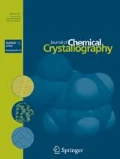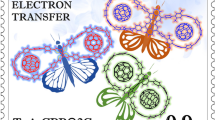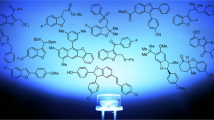Abstract
Single crystal X-ray diffraction analysis of upper rim functionalized tetrabromo-resorcin[4]arenes are presented and their guest encapsulation abilities are discussed. The Br-atoms either attached directly to resorcinarene rim or extended by methylene group (CH2–Br). The substituents on the upper-rim plays an important role in the guest encapsulation characteristic of the resorcinarene cavity. In the crystal structure the host–guest supramolecular systems were stabilized by C–H⋯O, C–H⋯π and C⋯H···Br nonbonding interactions. The Hirshfeld surfaces analysis and the related 2D fingerprint plots provided qualitative and quantitative account of the various supramolecular non-bonding interactions present within the crystal.
Graphic Abstract
Guest encapsulation characteristic of tetrabromo-functionalized resorcin[4]arenes.










Similar content being viewed by others
References
Atwood JL, Gokel GW, Barbour L (eds) (2017) Comprehensive supramolecular chemistry II. Elsevier Science, Oxford
Saylan Y, Erdem Ö, Inci F, Denizli A (2020) Advances in biomimetic systems for molecular recognition and biosensing. Biomimetics 5:20
Gangemi CMA, Pappalardo A, Sfrazzetto GT (2015) Applications of supramolecular capsules derived from resorcin[4]arenes, calix[n]arenes and metallo-ligands: from biology to catalysis. RSC Adv 5:51919–51933
Knipe PC, Thompson S, Hamilton AD (2016) Molecular recognition in biomimetic receptors. In: Izatt RM (ed) Macrocyclic and supramolecular chemistry: how Izatt-Christensen Award winners shaped the field. Wiley, Hoboken
Li J (ed) (2017) Supramolecular CHEMISTRY OF BIOMIMETIC SYSTEMS. Springer, New York
Pinalli R, Boccini F, Dalcanale E (2011) Cavitand-based coordination cages: achievements and current challenges. Isr J Chem 51:781–797
Jain VK, Kanaiya PH (2011) Chemistry of calix[4]resorcinarenes. Russ Chem Rev 80:75–102
Al-Azemi TF, Vinodh M, Alipour FH (2016) Bis-resorcin[4]arene–bridged porphyrin conjugates: synthesis, fluorescence and binding studies. RSC Adv 6:76482–76489
Al-Azemi TF, Vinodh M (2015) Effect of the resorcin[4]arene host on the catalytic epoxidation of a Mn(III)-based resorcin[4]arene–metalloporphyrin conjugate. RSC Adv 5:88154–88159
Zhang Q, Catti L, Tiefenbacher K (2018) Catalysis inside the hexameric resorcinarene capsule. Acc Chem Res 51:2107–2114
Puttreddy R, Beyeh NK, Taimoory SM, Meister D, Trantand JF, Rissanen K (2018) Host–guest complexes of conformationally flexible C-hexyl-2-bromoresorcinarene and aromatic N-oxides: solid-state, solution and computational studies. Beilstein J Org Chem 14:1723–1733
Schroeder T, Sahu SN, Mattay J (2012) Molecular capsules derived from resorcin[4]arenes by metal-coordination. Top Curr Chem 319:99–124
Beyeh NK, Rissanen K (2011) Dimericresorcin[4]arene capsules in the solid state. Isr J Chem 51:769–780
Lu BB, Yang J, Liu YY, Ma JF (2017) A polyoxovanadate–resorcin[4]arene-based porous metal–organic framework as an efficient multifunctional catalyst for the cycloaddition of CO2 with epoxides and the selective oxidation of sulfides. Inorg Chem 56:11710–11720
Liu W, Yang H, Wu W, Gao H, Xu S, Guo Q, Liu Y, Xu S, Cao S (2016) Calix[4]resorcinarene-based branched macromolecules for all-optical photorefractive applications. J Mater Chem C 4:10684–10690
Zong W, Wang L, Guo Q, Li J, Wu W, Liu Y, Xu S, Cao S (2019) A calix[4]resorcinarene-based hyper-structured molecule bearing disperse red 1 as the chromophore with enhanced photorefractive performance under non-electric field. Dyes Pigm 160:579–586
Zhai QY, Su J, Guo TT, Yang J, Ma JF, Chen JS (2018) Two porous polyoxometalate-resorcin[4]arene-based supramolecular complexes: selective adsorption of organic dyes and electrochemical properties. Cryst Growth Des 18:6046–6053
Kobayashi K, Yamanakaa M (2015) Self-assembled capsules based on tetrafunctionalized calix[4]resorcinarene cavitands. Chem Soc Rev 44:449–466
Smith JN, Lucas NT (2018) Rigid tetraarylene-bridged cavitands from reduced-symmetry resorcin[4]arene derivatives. Chem Commun 54:4716–4719
Husain AA, Maknenko AM, Bisht KS (2016) Spatially directional resorcin[4]arene cavitand glycoconjugates for organic catalysis. Chem Eur J 22:6223–6227
Corradi S, Mazzoccanti G, Ghirga F, Quaglio D, Nevola L, Massera C, Ugozzoli F, Giannini G, Alessia Ciogli A, D’Acquarica I (2018) Synthesis of bromoundecyl resorc[4]arenes and applications of the cone stereoisomer as selector for liquid chromatography. J Org Chem 83:7683–7693
Al-Azemi TF, Vinodh M (2011) Synthesis of porphyrin conjugates based on conformationally rigid and flexible resorcin[4]arene frameworks. Tetrahedron 67:2585–2590
Vinodh M, Al-Azemi TF (2019) Cavitand and flexible amphiphilic resorcin[4]arenes: structural characterization and supramolecular interactions in crystal networks. J Chem Crytallogr. https://doi.org/10.1007/s10870-019-00819-z
Pinalli R, Dalcanale E, Ugozzoli F, Massera C (2016) Resorcinarene-based cavitands as building blocks for crystal engineering. CrystEngComm 18:5788–5802
Nakamura A, Sato T, Kuroda R (2003) Novel layered structures of the crystals based on C-methylcalix[4]resorcinarene formed at high temperature. CrystEngComm 5:318–325
Pedrini A (2019) Host–guest supramolecular interactions between a resorcinarene-based cavitand bearing a –COOH moiety and acetic acid. Acta Crystallogr E Cryst Commun 75:397–401
Gropp C, Quigley BL, Diederich F (2018) Molecular recognition with resorcin[4]arene cavitands: switching, halogen-bonded capsules, and enantioselective complexation. J Am Chem Soc 140:2705–2717
Purse BW, Rebek J (2005) Functional cavitands: chemical reactivity in structured environments. Proc Natl Acad Sci USA 102:10777–10782
Helttunen K, Shahgaldian P (2010) Self-assembly of amphiphilic calixarenes and resorcinarenes in water. New J Chem 34:2704–2714
Turner MJ, McKinnon JJ, Wolff SK, Grimwood DJ, Spackman PR, Jayatilaka D, Spackman AM, CrystalExplorer17 (2017). University of Western Australia. http://hirshfeldsurface.ne
Wu R, Al-Azemi TF, Bisht KS (2009) Spatially directional multiarm poly(epsilon-caprolactone) based on resorcin[4]arene cavitand core. Chem Commun 14:1822–1824
Ruizhi W, Al-Azemi TF, Bisht KS (2014) Influence of a resorcin[4]arene core structure on the spatial directionality of multi-arm poly(ε-caprolactone)s. RSC Adv 4:16864–16870
Dueno EE, Bisht KS (2004) Synthesis of polyhydroxy cavitands and intramolecular inclusion of their octaester derivatives. Tetrahedron 60:10859–10868
Sheldrick GM (2015) Crystal structure refinement with SHELXL. Acta Cryst C71:3–8
Spackman AM, Jayatilaka D (2009) Hirshfeld surface analysis. CrystEngComm 11:19–32
McKinnon JJ, Spackman MA, Mitchell AS (2004) Novel tools for visualizing and exploring intermolecular interactions in molecular crystals. Acta Cryst B 60:627–668
McKinnon JJ, Jayatilaka D, Spackman AM (2007) Towards quantitative analysis of intermolecular interactions with Hirshfeld surfaces. Chem Commun 37:3814–3816
Acknowledgements
The support received from the University of Kuwait, made available through research grant no. SC 09/09, and the facilities of RSPU (Grant Nos. GS 03/08, GS 01/01 and GS 01/03) are gratefully acknowledged.
Author information
Authors and Affiliations
Corresponding author
Additional information
Publisher's Note
Springer Nature remains neutral with regard to jurisdictional claims in published maps and institutional affiliations.
Supplementary Information
Below is the link to the electronic supplementary material.
10870_2021_889_MOESM1_ESM.docx
Supplementary file1 (DOCX 6207 KB)
Single crystal data for compounds RCBr4 (CCDC XXXX), and RCCH2Br4 (CCDC XXX) have been deposited in the Cambridge Crystallographic Data Center. Supplementary data associated with this article can be found, in the online version at http://www.ccdc.cam.ac.uk/conts/retrieving.html
Rights and permissions
About this article
Cite this article
Vinodh, M., Al‑Azemi, T.F. Encapsulation Characteristics of Cavitand Type Tetrabromo-Functionalized Resorcin[4]arenes in the Crystal Structure. J Chem Crystallogr 52, 43–52 (2022). https://doi.org/10.1007/s10870-021-00889-y
Received:
Accepted:
Published:
Issue Date:
DOI: https://doi.org/10.1007/s10870-021-00889-y




